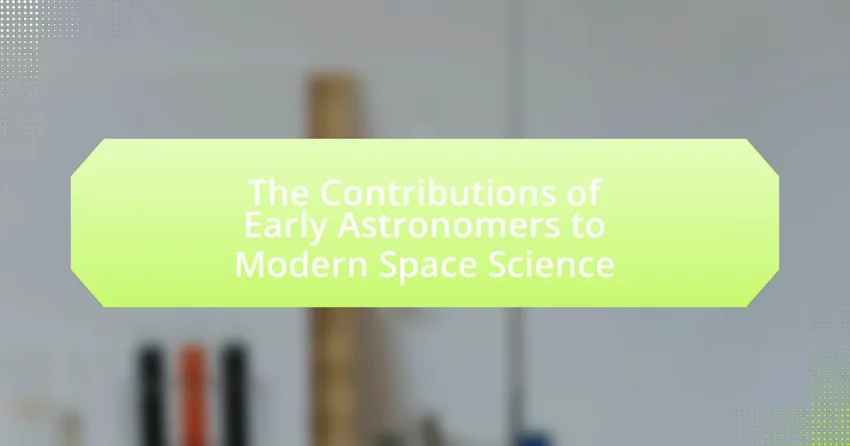The article examines the significant contributions of early astronomers to modern space science, highlighting key figures such as Ptolemy, Copernicus, Kepler, and Galileo. It discusses how their foundational observations and theories, including the geocentric and heliocentric models, laws of planetary motion, and advancements in observational techniques, shaped contemporary understanding of celestial mechanics and the universe. The article also explores the relevance of these early theories in current space exploration and navigation, emphasizing the lasting legacy of early astronomers in the field of astrophysics and the scientific method.

What are the key contributions of early astronomers to modern space science?
Early astronomers significantly advanced modern space science through their foundational observations and theories. Ptolemy’s geocentric model, although later replaced, established a systematic approach to celestial mechanics that influenced future astronomical models. Copernicus introduced the heliocentric theory, which revolutionized the understanding of the solar system and laid the groundwork for Kepler’s laws of planetary motion, demonstrating that planets move in elliptical orbits. Galileo’s use of the telescope provided empirical evidence for these theories, revealing celestial bodies such as Jupiter’s moons and the phases of Venus, which supported the heliocentric model. Additionally, Tycho Brahe’s precise astronomical measurements enabled Kepler to formulate his laws of motion, which are essential for modern orbital mechanics. These contributions collectively shaped the scientific method in astronomy and provided the basis for contemporary space exploration and understanding of the universe.
How did early astronomers influence our understanding of the universe?
Early astronomers significantly influenced our understanding of the universe by developing foundational models of celestial mechanics and observational techniques. For instance, Ptolemy’s geocentric model, detailed in the Almagest, provided a systematic framework for predicting planetary positions, which persisted for over a millennium. Additionally, Copernicus introduced the heliocentric model in “De revolutionibus orbium coelestium,” fundamentally shifting the perspective of Earth’s place in the cosmos. These early contributions laid the groundwork for later advancements in astronomy, such as Kepler’s laws of planetary motion and Galileo’s telescopic observations, which collectively enhanced our comprehension of celestial bodies and their movements.
What discoveries did early astronomers make about celestial bodies?
Early astronomers discovered that celestial bodies, such as planets and stars, follow predictable paths and exhibit distinct characteristics. For instance, Ptolemy’s geocentric model detailed the movements of planets relative to Earth, while Copernicus proposed a heliocentric model, positioning the Sun at the center of the solar system. Additionally, Galileo’s observations through a telescope revealed the moons of Jupiter and the phases of Venus, providing evidence for the heliocentric theory. These foundational discoveries laid the groundwork for modern astronomy and our understanding of the universe.
How did early observational techniques shape modern astronomy?
Early observational techniques laid the groundwork for modern astronomy by establishing fundamental methods for studying celestial bodies. Techniques such as the use of the astrolabe and the telescope allowed astronomers like Galileo and Tycho Brahe to make precise measurements of planetary positions and movements. These observations led to the formulation of key astronomical models, including the heliocentric model proposed by Copernicus, which fundamentally changed our understanding of the solar system. The accuracy of early observations also contributed to the development of mathematical frameworks, such as Kepler’s laws of planetary motion, which are still essential in contemporary celestial mechanics. Thus, the innovations in observational techniques directly influenced the methodologies and theories that underpin modern astronomical research.
Why are the theories proposed by early astronomers still relevant today?
The theories proposed by early astronomers remain relevant today because they laid the foundational principles of modern astronomy and influenced contemporary scientific methods. For instance, the heliocentric model introduced by Copernicus revolutionized our understanding of the solar system, leading to advancements in celestial mechanics and observational techniques. Additionally, Kepler’s laws of planetary motion provided critical insights into the orbits of planets, which are still used in space mission planning and satellite deployment. These early theories established a framework for empirical observation and mathematical modeling that continues to guide astronomical research and exploration.
What role did early models of the solar system play in contemporary science?
Early models of the solar system, such as the geocentric and heliocentric models, laid the foundational framework for contemporary science by establishing the principles of celestial mechanics and observational astronomy. The geocentric model, proposed by Ptolemy, emphasized the importance of systematic observation, while Copernicus’s heliocentric model revolutionized the understanding of planetary motion, leading to Kepler’s laws of planetary motion and Newton’s law of universal gravitation. These developments provided the basis for modern astrophysics and space exploration, enabling accurate predictions of celestial events and the advancement of technologies such as satellite navigation and space travel.
How did early astronomers contribute to the development of scientific methods?
Early astronomers significantly contributed to the development of scientific methods by employing systematic observation and empirical data collection to understand celestial phenomena. For instance, figures like Claudius Ptolemy and Nicolaus Copernicus meticulously recorded planetary movements and developed models based on their observations, laying the groundwork for hypothesis testing. Their work emphasized the importance of repeatable observations and mathematical calculations, which are fundamental principles of the scientific method. Additionally, the transition from geocentric to heliocentric models exemplified the iterative process of refining theories based on new evidence, a core aspect of scientific inquiry.

What specific early astronomers made significant contributions to space science?
Early astronomers who made significant contributions to space science include Claudius Ptolemy, Nicolaus Copernicus, Johannes Kepler, and Galileo Galilei. Claudius Ptolemy, in the 2nd century, developed the geocentric model of the universe, which influenced astronomical thought for over a millennium. Nicolaus Copernicus, in the 16th century, proposed the heliocentric model, fundamentally changing the understanding of the solar system. Johannes Kepler, in the early 17th century, formulated the laws of planetary motion, providing a mathematical framework for celestial mechanics. Galileo Galilei, also in the 17th century, utilized the telescope to make groundbreaking observations, such as the moons of Jupiter, which supported the heliocentric theory. These contributions laid the groundwork for modern astronomy and space science.
Who were the most influential early astronomers and what were their key findings?
The most influential early astronomers include Claudius Ptolemy, Nicolaus Copernicus, Johannes Kepler, and Galileo Galilei, each contributing significantly to the field. Claudius Ptolemy’s key finding was the geocentric model of the universe, detailed in his work “Almagest,” which posited that the Earth was at the center of the universe. Nicolaus Copernicus revolutionized astronomy with his heliocentric model, asserting that the Sun, not the Earth, was the center of the universe, as presented in “De revolutionibus orbium coelestium.” Johannes Kepler formulated the laws of planetary motion, demonstrating that planets move in elliptical orbits around the Sun, which he published in “Astronomia nova.” Galileo Galilei made groundbreaking observations using a telescope, including the moons of Jupiter and the phases of Venus, which supported the heliocentric theory and were documented in “Sidereus Nuncius.” These findings laid the groundwork for modern astronomy and challenged existing beliefs about the cosmos.
What contributions did Copernicus make to heliocentric theory?
Copernicus significantly advanced heliocentric theory by proposing that the Sun, rather than the Earth, is at the center of the universe. His seminal work, “De revolutionibus orbium coelestium,” published in 1543, outlined this revolutionary model, challenging the long-standing geocentric view held by Ptolemy. Copernicus introduced the concept of planetary motion in circular orbits around the Sun, which provided a more coherent explanation for the observed movements of celestial bodies. His model laid the groundwork for future astronomers, such as Kepler and Galileo, to further develop and refine the understanding of our solar system, ultimately leading to the acceptance of heliocentrism in modern astronomy.
How did Galileo’s observations change the course of astronomy?
Galileo’s observations fundamentally transformed astronomy by providing empirical evidence that supported the heliocentric model, which posits that the Earth and other planets revolve around the Sun. His use of the telescope allowed him to discover celestial phenomena such as the moons of Jupiter, the phases of Venus, and the detailed surface of the Moon, which contradicted the prevailing geocentric view that placed Earth at the center of the universe. These findings were documented in his work “Sidereus Nuncius,” published in 1610, where he presented his observations and argued for a Sun-centered solar system. Galileo’s insistence on observation and experimentation laid the groundwork for the scientific method, significantly advancing the field of astronomy and influencing future scientists like Kepler and Newton.
What tools and methods did early astronomers use to advance their studies?
Early astronomers advanced their studies using tools such as the astrolabe, quadrant, and telescope, along with methods like careful observation and mathematical calculations. The astrolabe, developed in ancient Greece, allowed astronomers to measure the altitude of celestial bodies, facilitating navigation and timekeeping. The quadrant, used extensively during the Renaissance, enabled precise measurements of angles in the sky. The invention of the telescope in the early 17th century by Galileo Galilei revolutionized astronomy by allowing for detailed observations of planets and moons, leading to significant discoveries such as the moons of Jupiter. These tools and methods collectively enhanced the understanding of celestial phenomena and laid the groundwork for modern astronomy.
How did the invention of the telescope impact astronomical discoveries?
The invention of the telescope significantly advanced astronomical discoveries by enabling astronomers to observe celestial objects with unprecedented clarity and detail. This technological breakthrough allowed for the identification of previously unseen planets, moons, and stars, fundamentally altering humanity’s understanding of the universe. For instance, Galileo Galilei’s use of the telescope in the early 17th century led to the discovery of Jupiter’s four largest moons, known as the Galilean moons, which provided evidence against the geocentric model of the solar system. Additionally, telescopes facilitated the observation of the phases of Venus, supporting the heliocentric theory proposed by Copernicus. These discoveries exemplify how the telescope transformed astronomy from a largely theoretical discipline into an empirical science, laying the groundwork for modern astrophysics.
What were the limitations of early astronomical tools and how were they overcome?
Early astronomical tools, such as the astrolabe and rudimentary telescopes, faced limitations including low precision, inability to observe distant celestial bodies, and lack of advanced optics. These limitations were overcome through advancements in technology, such as the development of the refracting telescope by Hans Lippershey in 1608, which improved magnification and clarity, and the introduction of the reflecting telescope by Isaac Newton in 1668, which eliminated chromatic aberration. Additionally, the invention of more precise instruments like the sextant and advancements in mathematics and observational techniques allowed astronomers to make more accurate measurements and predictions, significantly enhancing our understanding of the cosmos.

How do the contributions of early astronomers connect to modern space exploration?
The contributions of early astronomers are foundational to modern space exploration by establishing the principles of celestial mechanics and observational techniques. Early astronomers like Copernicus, who proposed the heliocentric model, and Kepler, who formulated the laws of planetary motion, provided the theoretical framework that underpins our understanding of planetary orbits and gravitational interactions. These principles are crucial for the navigation and trajectory planning of spacecraft. Additionally, the invention of telescopes by astronomers such as Galileo enabled detailed observations of celestial bodies, leading to discoveries that inform current missions, such as the identification of exoplanets and the study of planetary atmospheres. The methodologies developed by early astronomers continue to influence modern observational strategies and technologies used in space exploration today.
What foundational concepts from early astronomy are applied in current space missions?
Foundational concepts from early astronomy, such as the heliocentric model and celestial navigation, are applied in current space missions. The heliocentric model, proposed by Copernicus, established that planets orbit the Sun, which is crucial for trajectory calculations in missions like the Mars rovers and Voyager spacecraft. Celestial navigation, used by ancient astronomers to determine positions based on stars, is still relevant for spacecraft navigation, allowing for accurate positioning and course adjustments during missions. These concepts form the basis for understanding planetary motion and navigation, essential for the success of modern space exploration.
How do early astronomical calculations influence modern navigation in space?
Early astronomical calculations provide foundational principles that modern space navigation relies on, particularly in celestial mechanics and positional astronomy. These calculations, developed by astronomers such as Ptolemy and Copernicus, established methods for predicting planetary positions and understanding gravitational influences, which are crucial for trajectory planning in space missions. For instance, the laws of planetary motion formulated by Johannes Kepler in the 17th century laid the groundwork for calculating orbits, enabling spacecraft to navigate efficiently between celestial bodies. The accuracy of these early calculations is evidenced by their continued application in modern algorithms used for spacecraft navigation, such as the patched conic approximation, which simplifies complex gravitational interactions based on historical models.
What legacy do early astronomers leave in the field of astrophysics?
Early astronomers established foundational principles and observational techniques that significantly shaped the field of astrophysics. Their meticulous observations of celestial bodies, such as those conducted by Copernicus, Galileo, and Kepler, led to the heliocentric model and the laws of planetary motion, which are crucial for understanding gravitational interactions and orbital mechanics. Furthermore, the introduction of telescopes by Galileo allowed for unprecedented detail in observing the night sky, paving the way for future discoveries in astrophysics. The legacy of these astronomers is evident in modern astrophysical research, which builds upon their methodologies and findings to explore the universe’s structure, composition, and evolution.
What lessons can modern astronomers learn from early astronomers’ approaches?
Modern astronomers can learn the importance of meticulous observation and record-keeping from early astronomers’ approaches. Early astronomers, such as Ptolemy and Copernicus, relied heavily on detailed observations of celestial bodies, which laid the groundwork for future astronomical models. Their systematic documentation of planetary movements and star positions enabled later scientists to refine these models, ultimately leading to the heliocentric theory. This historical emphasis on careful observation underscores the necessity for modern astronomers to maintain rigorous data collection practices, as accurate records are essential for validating theories and advancing knowledge in the field.
How can the collaborative spirit of early astronomers inspire today’s scientific community?
The collaborative spirit of early astronomers can inspire today’s scientific community by emphasizing the importance of shared knowledge and teamwork in advancing scientific discovery. Early astronomers, such as Tycho Brahe and Johannes Kepler, worked together to compile extensive observational data, which led to significant breakthroughs in understanding planetary motion. This historical collaboration demonstrates that collective efforts can yield more comprehensive insights than isolated research, encouraging modern scientists to engage in interdisciplinary partnerships and open data sharing. Such collaboration is evident in contemporary projects like the Event Horizon Telescope, where global teams united to capture the first image of a black hole, showcasing how the legacy of early astronomers continues to shape collaborative scientific endeavors today.
What best practices from early astronomy can enhance current research methodologies?
Best practices from early astronomy that can enhance current research methodologies include meticulous observational record-keeping and the use of systematic classification. Early astronomers, such as Tycho Brahe, emphasized detailed and accurate observations of celestial bodies, which laid the groundwork for future discoveries. This practice of thorough documentation allows modern researchers to analyze historical data alongside contemporary findings, improving the accuracy of models and predictions. Additionally, the classification systems developed by early astronomers, like Johannes Kepler’s laws of planetary motion, provide a framework for organizing and interpreting complex astronomical data, facilitating better understanding and communication of research outcomes. These foundational practices underscore the importance of precision and systematic approaches in advancing modern astronomical research.
